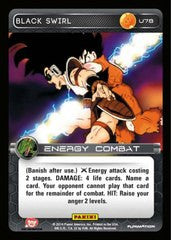
Before taking a look at the remaining regional winner decks (Nathan W.’s Orange Krillin and Carl’s Namekian Piccolo), we wanted to highlight a regional finalist’s deck showcasing some of the versatility in deck choices available in the meta environment.
Nash piloted Red Piccolo all the way to a Top 4 showdown and proved Piccolo isn’t just a one trick pony with a Namekian deck. It is true, however, that some of the synergy between Piccolo’s personality powers and an MPPV victory remains just as valid in Red style as it does in Namekian. But the Red varient utilises some burst anger that only Tenshinhan can reliably match.
Piccolo does some great work from level 2 to 4, and uses those powers to his advantage to max out his anger either by directly using a critical damage effect or giving Piccolo the tools to generate one through damage. His only drawback in Red is his Level 1. With no anger gain other than cards drawn, this can sometimes leave Red Piccolo vulnerable early game. By maxing out on Red’s cards that gain 2 anger with secondary or hit effects, this helps to mitigate some of those problems.
I’m particularly impressed by the use of the sole Red Tactical Drill in the deck. On face value this might seem like wasted space, but when you team it with Red Stop which can grab the drill back to potentially help conserve anger it can put in some great work. This also adds to the flexibility of the defensive package in the deck. A vulnerability present is the reduced amount of pure energy blocks in the deck, which leaves you open to having your anger reduced via critical damage effects generated by your opponent’s energy attacks. Red Energy Defensive Stance is the favoured second energy block I see in most Red decks to help with anger.

Having the Dragon Balls in deck as well to give a back up win condition is a great part of this deck. By making your opponent choose between you keeping your anger, or keeping your Dragon Balls, you keep some of the power on your side of the table.
The attacks used in the deck are all very solid. By focusing on using a majority of physical attacks to gain anger, you leave your opponent unable to stage lock you into not being able to play your attacks. When teamed with physical blocks being slightly less prevalent in the environment, it gives the deck some great tools to press on with a Survival Victory if it catches someone unprepared to halt the chain of attacks Red has the potential of bringing to the table.
With only 14 cards in the deck that can’t be used during the defender phase, it represents a good balance to help ensure you can pin your ears back and go for your wins either as the attacker or defender in most draw phases. And with multiple ways to help cycle cards in and out of your hand, the deck shouldn’t be as susceptible to bricked hands like some other Red decks can be.
If I was looking at this deck for ways to improve it, I would like to see cards like Red Left Bolt or Red Heel Kick added into the mix to help keep combats going. The longer you keep your opponent in combat, and generating anger through critical damage effects or pure secondary effects the better. Both these cards offer you ways to keep setting up your combats. Red Left Bolt isn’t going to get you the same value in Piccolo as it would in a Tenshinhan build, but you can always make sure that the card on the bottom of your deck is going to keep the anger train rolling.
These types of decks add some great variety to the meta, keeping everyone honest in their own deck building to be mindful of a burst anger deck that they might not see coming. As Nash showed, you can get some good success with Red in a meta that might be expecting more of the usual players in Ginyu, Krillin and Namekian Piccolo.
Good luck and game on!
– Trent (@TAKGames_Trent) and Kyp (@justkyp).


 The thing most people would find surprising is the amount of “1 of” cards in the deck. But such is the nature of Namekian. It can get away with this easily, giving the pilot the choice of cards they need to retrieve with searchers like
The thing most people would find surprising is the amount of “1 of” cards in the deck. But such is the nature of Namekian. It can get away with this easily, giving the pilot the choice of cards they need to retrieve with searchers like 
